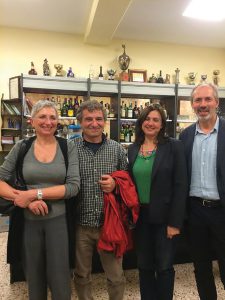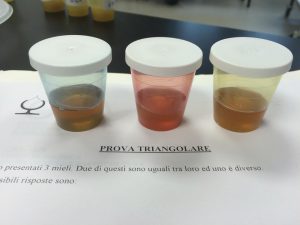So you want to be a honey sommelier?
By: Marina Marchese

Left to Right: Lucia Piana, Marco Valentina, Marina and Gian Luigi Marcazzan – experts and teachers in Sensory Analysis of Honey.
Raffaele lifted the glass of honey to capture the sunlight that illuminated the classroom. He took note of its unmistakable egg-yoke color and firm, compact crystals. Using a white spoon, he used brush-like strokes to spread the honey around the sides of the glass. Without hesitation he stuck his nose inside, took a deep sniff then scooped up a dollop and let it melt on his tongue. The words he chose to describe the honey were delicate, not excessively sweet with flavors of cooked fruit, marmalade, green vegetables, dry hay and fresh bee pollen. Resembling everything he knew about the sensory qualities of a sunflower honey.
There’s a quote by Kurt Vonnegut that goes “You can’t just eat good food. You’ve got to talk about it too. And you’ve got to talk about it to somebody who understands that kind of food.” Over the last few years I spent some time in Italy with people who understand honey and talk about its sensory qualities paralleling that of a wine sommelier. They are The Experts in the Sensory Analysis of Honey who have perfected the art and science of identifying Italian honeys by floral sources and regions simply by tasting it. Sound impressive? I can tell you from experience that practice along with a really good memory and tasting notes can make perfect. I should also mention that most of these honey experts also produce wine and olive oil as well as honey, so this gift runs through their veins most likely for generations.
So it makes perfect sense that Italy has a national register of honey tasting experts and offers honey-tasting courses. Also in true Italian style, these courses are held somewhat randomly in various cities around the country. There’s one more catch, besides securing your passport and airfare, you’ll have to brush up on your Italian as the courses are only offered in their native tongue. If you’re still intrigued, read on as I share with you what I learned from the Italian honey tasting experts.
I became obsessed with the notion of honey tasting during my visit to the National Honey show in London back in 2003, the judges tasting skills were mesmerizing and upon my return I promptly sent myself to The University of Georgia for an introductory honey judging class. Ultimately, I concluded that in order to become a truly accomplished taster, it would make sense to immerse myself into the world of wine so I scored myself a position working under a master somm.
It was while wandering the vineyards of Montalcino, Italy, that I serendipitously stumbled upon a honey festival where I would sit in on an impromptu honey tasting demonstration. The universe works in strange ways and not too long after my return home, I received an invitation to join a honey tasting group on LinkedIn from Raffaele, where he posted the dates for an introductory honey tasting course he would be teaching on the island of Sardinia.
I was not a stranger to Sardinia. A few years earlier I attended their annual honey festival then spent some time visiting beekeepers, so a honey-tasting course was an excellent excuse to return. Once I landed in the capital city of Cagliari, I rented a car and drove almost two hours west up the coast to the small town of Guspini. Navigating parts of the island can be full of surprises and it’s not uncommon to find yourself driving alongside grazing goats or hugging dirt roads at the edge of a mountainside. Sardinia’s pristine beaches and traditional seadas, an over-sized, fried ravioli stuffed with local cheese and honey is not to be missed.
The course was four eye-opening days of sensory training and honey tasting. Class size was limited to 25 people including beekeepers, food and health industry professionals, all from around the island. Surrounded by our notebooks, score sheets, plastic biodegradable tasteless spoons, bottles of water and green apples for palate cleansers, we were absorbed in hours of tasting, talking and note taking about honey. Sensory exercises began with recognizing and identifying the basic taste sensations: sweet, sour, bitter, salty and umami (Japanese for savory). Humans are only capable of tasting the sweetness of honey on our tongues and flavors like jasmine, strawberries, nutmeg or camphor are recognized by our olfactory bulb in our nose only while inhaling with honey on our tongue mixed with a good amount of saliva. This is why we cannot taste chicken soup with a stuffy or pinched nose and why it is important to smell your honey before fully tasting it. The tasting flights consisted of 20 uni-floral Italian honeys in which we learned a wide range of aroma and flavor terminology from the Italian honey tasting wheel to describe each one. The exercises began with a procession of pushcarts filled with perfect rows of honey samples in transparent stemmed glasses. Surprisingly, not one glass of honey was labeled since it would be up to us to identify each by smell and flavor only. Our instructors always tasted with us and we would compare our impressions and tasting notes at the end of each exercise. A few tasting notes that I found to be memorable were for Corbezzolo honey (Arbutus unedo L.: Strawberry tree): bitter, persistent, smoky and ashtray, Tarassaco honey (Taraxacum officinale Weber: Dandelion): floral, feet, barn stall, intense with a short finish and Tiglio honey (Tilia spp. –Tiliaceae: Lime tree): medium intense, balsamic, medicine cabinet, tannic and camphorous. The tasting notes for every Italian uni-floral honey have been pre-established and agreed upon by a panel of experts. No doubt, it was a monumental task getting beekeepers to agree on something. In between tasting exercises, there were lectures about bee and honey topics related to bee anatomy, honey making and harvest, plants and their regions, pollen id, labeling requirements, understanding various aspects of crystallization and identifying defects and adulteration.
 During the entire course the class used close to 10,000 tasting spoons, hundreds of tasting glasses and tasted close to 50 pounds of honey! Afterwards, we were awarded certifications from the mayor of Guspini at the honey festival in Montevecchio. I was touched when my fellow classmates gave me a small charm made in the traditional silver lace-work of Sardinia as a reminder of the time we spent together. Upon my return back to the states, I received a tasting kit of unmarked honeys to self-test in order to retain the sensory memories I had created until the next course.
During the entire course the class used close to 10,000 tasting spoons, hundreds of tasting glasses and tasted close to 50 pounds of honey! Afterwards, we were awarded certifications from the mayor of Guspini at the honey festival in Montevecchio. I was touched when my fellow classmates gave me a small charm made in the traditional silver lace-work of Sardinia as a reminder of the time we spent together. Upon my return back to the states, I received a tasting kit of unmarked honeys to self-test in order to retain the sensory memories I had created until the next course.
This past October I returned to Italy for the advanced honey tasting course, this time held in Bologna at the National Institute of Apiculture. Bologna is the antithesis of Guspini, a lively city and home to the University of Bologna one of the oldest universities in the world. The historical center is where you’ll find bustling piazzas that lead to Bologna’s historic towers, endless shopping and restaurants tucked under medieval porticos and some of the best gelato ever. This trip I decided to arrive a few days early so I could adjust to the time difference as jetlag will suck your energy and dim your senses. Attendees must have completed the introductory course before applying for level l. Class size is limited to 15 and for three entire days we were challenged to recognize and identify honey samples at a quicker pace. At 9:00 our senses were at their sharpest so each morning we jumped right into blind tasting tests to identify the floral sources of 10 uni-floral honey samples. This is where your notes on flavor profiles along with your senses would be the only thing you had to rely on. We tasted liquid as well as crystallized samples and learned a complete vocabulary to describe every sensory aspect including crystal size, quality, texture and viscosity. Advanced exercises consisted of identifying honey in amber tinted jars by aroma only and in another we were given groups of three unmarked samples in which we had to decide which two samples were similar. Perhaps the most merciless challenge was to identify the two predominant floral sources in samples that were deliberately mixed in pre-determined proportions then calculate the percentages of each. Our individual responses were tallied up and plugged into a database then compared with those of other classes and the experts. I never imagined there could be so much involved with learning how to tasting honey and left Bologna with new friends, another certificate and a deeper reverence for the skills and training needed to be a honey sommelier. No one is born an expert, the skills required to master these sensory exercises can be acquired through thoughtful repetitive tastings. Eventually aroma and flavor memories are created, some come quicker and lasted longer than others. It’s essential to keep notes on every sample you taste and continue working on a regular basis. In March 2015, I return to Bologna for another advanced course – I have lots of tasting and studying up to do. In the future, I hope to bring some of these honey experts to the U.S. to teach but in the meantime, I will be sharing my honey tasting education by offering Introductory Honey Tasting Courses for individuals and organizations through The American Honey Tasting Society.
Marina Marchese is the designer and beekeeper behind the beloved brand, Red Bee Honey and the co-author of The Honey Connoisseur: Selecting, Tasting, and Pairing Honey. She is a leading expert on single – origin honey and the founder of The American Honey Tasting Society. For more info about honey tasting education visit americanhoneytastingsociety.com.






